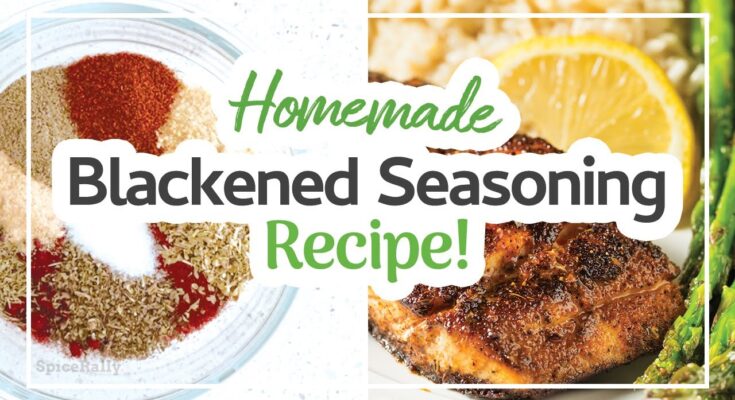Blackened Seasoning Recipe: Blackened seasoning is a bold, fiery spice blend that’s packed with flavor and has a smoky kick. This Southern classic combines spices like paprika, cayenne, garlic powder, onion powder, thyme, oregano, and black pepper into a perfect harmony of heat and herbs. It’s used to coat meat, fish, or even vegetables before cooking at high heat—usually in a cast-iron skillet—to create a dark, “blackened” crust that locks in juicy flavor.
The beauty of blackened seasoning is its versatility. Whether you’re spicing up shrimp tacos, jazzing up chicken breasts, or firing up a grilled steak, this seasoning blend transforms ordinary meals into unforgettable experiences. The intense heat of the seasoning works beautifully with high-heat cooking techniques, producing a charred, flavorful crust while sealing in natural juices.
This isn’t just about heat—blackened seasoning is about balance. The sweet paprika mellows out the fiery cayenne, while the herbs provide an earthy, aromatic base. A well-balanced blackened seasoning delivers layers of taste with every bite—smoky, spicy, savory, and slightly sweet.
Origins and Cultural Significance
Blackened seasoning comes from the heart of Cajun and Creole cooking, particularly from Louisiana. The term “blackened” was popularized by legendary chef Paul Prudhomme in the 1980s, when he introduced blackened redfish to the culinary world. His technique involved coating the fish in a spice rub and searing it in a hot skillet, creating a deep crust and smoky aroma that captivated diners and cooks alike.
This cooking style quickly became a favorite across the U.S., especially in Southern kitchens. While Cajun and Creole cuisines have many spice blends, blackened seasoning stands out for its dramatic appearance and intense flavor. Today, it’s not just reserved for seafood—home cooks and chefs use it across proteins, veggies, and even tofu.
Blackened seasoning has become a staple in many kitchens not just because it tastes great, but because it embodies the vibrant, soulful essence of Louisiana cooking. When you use it, you’re tapping into a rich culinary tradition that celebrates bold flavors, simple ingredients, and big, satisfying meals.
Ingredients for Homemade Blackened Seasoning
Core Spices and Herbs
To make authentic blackened seasoning at home, you’ll need a mix of spices and dried herbs. The base blend includes:
- Paprika (2 tablespoons) – adds smoky sweetness and deep red color.
- Cayenne Pepper (1 teaspoon) – for heat; adjust according to your spice tolerance.
- Garlic Powder (1 tablespoon) – brings savory depth.
- Onion Powder (1 tablespoon) – enhances flavor and complements garlic.
- Thyme (1 teaspoon) – a classic Cajun herb.
- Oregano (1 teaspoon) – adds a robust, earthy note.
- Black Pepper (1 teaspoon) – for that sharp bite.
- Salt (1 teaspoon) – balances the flavors.
These ingredients create a perfect base with enough spice and balance to elevate any dish. Feel free to double the recipe for larger batches—you’ll find yourself using it often.
Optional Add-ins for Custom Flavor
Want to give your blackened seasoning a personal twist? Here are a few extras you can mix in:
- Smoked Paprika – swaps in for regular paprika to add more smokiness.
- Brown Sugar (1 teaspoon) – for a touch of sweetness to counterbalance heat.
- Mustard Powder (1/2 teaspoon) – for tangy depth.
- Cumin (1/2 teaspoon) – for a warm, earthy backbone.
- White Pepper – for an additional peppery punch without the heaviness of black pepper.
By experimenting with these add-ins, you can create a version that suits your specific tastes or a particular dish. The flexibility of this blend is one of its biggest strengths—you can dial up the heat or tone it down, make it sweeter, or go more herbal depending on your mood and meal plan.
Tools and Equipment Needed
Mixing and Measuring Tools
Before you start whipping up your spice blend, you’ll want to gather the right tools. While blackened seasoning is simple to make, using the proper equipment ensures consistency and quality every time. Here’s what you’ll need:
- Measuring spoons – for accurate portioning.
- Small mixing bowl – to combine ingredients easily.
- Whisk or spoon – for even mixing.
- Small funnel (optional) – helps with transferring to a storage container without spilling.
Precision is key when blending spices. Even small measurement differences can throw off the balance of flavors, so take your time and measure each spice carefully.
Storage Tips and Containers
Once your blackened seasoning is mixed, you need to store it properly to keep it fresh and flavorful. Here are some handy tips:
- Use airtight containers – like glass spice jars or small mason jars.
- Label and date your blend – so you know what it is and when you made it.
- Store in a cool, dry place – away from direct sunlight and moisture to preserve flavor.
Homemade spice blends can last for up to 6 months, though you’ll probably use this one up long before that. Just give it a sniff each time—if the aroma fades, it’s time to whip up a new batch.
Step-by-Step Instructions to Make Blackened Seasoning
Step 1: Gather Your Ingredients
Start by gathering all the spices and herbs you’ll need. This step might seem basic, but having everything laid out beforehand ensures a smooth and stress-free mixing process. If you’re using optional add-ins, lay those out too.
Pro tip: Use fresh spices if possible. The more vibrant and aromatic your ingredients, the better your blackened seasoning will taste.
Step 2: Measure Precisely
Accuracy matters in spice blending. Using your measuring spoons, portion out each spice exactly as listed. Pour them into your mixing bowl one by one.
Don’t rush this step—proper measurements are the foundation of a perfectly balanced spice blend.
Step 3: Mix Thoroughly
Once all your spices are in the bowl, grab a small whisk or spoon and mix them together. Keep stirring until the color and texture are uniform. This ensures every scoop of seasoning has the right flavor mix.
Make sure there are no clumps, and scrape the sides of the bowl to get everything evenly distributed.
Step 4: Store Properly
Now transfer your seasoning into an airtight jar. Use a funnel if needed to avoid mess. Seal it tightly, label it with the date, and store it in your spice cabinet.
Now you’re ready to blacken everything from shrimp to chicken to tofu!
Tips for Using Blackened Seasoning in Cooking
Best Proteins for Blackening
When it comes to getting the most out of your blackened seasoning, the type of protein you use can make a huge difference. This bold, smoky spice blend is designed to shine on high-protein foods that can handle intense heat and a strong flavor punch.
Here are the best proteins to use with blackened seasoning:
- Chicken Breasts or Thighs – Chicken is a classic pairing. It absorbs flavors beautifully and creates a juicy, well-seasoned crust when seared.
- Fish (especially firm white fish) – Think redfish, catfish, snapper, tilapia, or even salmon. Fish takes on the seasoning quickly and crisps up nicely with a blackened crust.
- Shrimp – These little guys cook fast, and the seasoning caramelizes quickly, making for a spicy, crispy bite.
- Steak or Beef Cuts – Ribeyes and sirloins benefit from blackened seasoning’s bold profile. Sear them in a hot cast-iron pan for amazing crust and flavor.
- Tofu and Tempeh – For plant-based eaters, tofu and tempeh are excellent choices. Press the tofu first to remove moisture, then coat it generously before pan-searing.
- Pork Chops – These take on the heat well and cook up tender and juicy when blackened.
Blackening isn’t just about the seasoning—it’s about how the meat interacts with it. The protein should be dry before seasoning (pat it down with a paper towel), and lightly oiled to help the spices stick. Avoid marinating first—you want the spice mix to form a crust, not a sauce.
The goal is to sear the outside until dark and crisp while leaving the inside moist and flavorful. The result? A beautiful contrast of textures and flavors.
Cooking Methods: Pan, Grill, or Oven?
One of the coolest things about blackened seasoning is how versatile it is in terms of cooking methods. While it was originally created for use in a hot cast-iron skillet, you can successfully blacken with various cooking techniques. Here’s how each one works:
1. Cast-Iron Skillet (Traditional Method)
- Heat your skillet until it’s smoking hot. Seriously—you want it blazing.
- Lightly oil your seasoned meat or fish.
- Sear it quickly on each side, usually 2–3 minutes per side for thinner cuts.
- This method gives you the classic blackened crust and a smoky aroma that’s unbeatable.
2. Grill
- Preheat the grill to high heat.
- Oil the grill grates and the protein to prevent sticking.
- Cook over direct heat to get that blackened char.
- It’s perfect for larger cuts or when cooking for a crowd.
3. Oven
- Not the most traditional, but it works if you’re baking.
- Use the broiler to mimic the high heat of a skillet.
- Place seasoned food on a baking sheet and broil on high for 4–6 minutes per side.
- Great for less mess and an easier cleanup.
Each method brings out slightly different flavors and textures, but all highlight that deep, smoky, spicy crust. Just remember—blackening isn’t burning. It’s about creating a flavorful char, not a bitter one. Monitor the heat, and if things start to smoke excessively, reduce the temp slightly.
Also, keep your kitchen ventilated—blackening produces a good bit of smoke. Open a window, turn on the fan, and you’ll be good to go.
Health Benefits of Homemade Blackened Seasoning
Control Over Ingredients
One of the biggest benefits of making your own blackened seasoning? You get total control over what goes into it. Store-bought spice blends often include preservatives, anti-caking agents, added sugar, and even MSG. When you make it at home, you skip all that.
You decide:
- How much salt goes in
- What level of heat suits your palate
- Whether to make it gluten-free, low-sodium, or organic
It’s especially helpful for folks with dietary restrictions or food sensitivities.
Nutritional Boost from Spices
Did you know the spices in blackened seasoning come with health perks?
- Paprika – rich in antioxidants, supports eye health, and reduces inflammation.
- Cayenne Pepper – boosts metabolism and helps digestion.
- Garlic & Onion Powder – antibacterial, immune-boosting, and heart-friendly.
- Thyme & Oregano – packed with vitamins, antioxidants, and anti-inflammatory compounds.
Using these spices regularly (in moderation) can help support your immune system, improve circulation, and even reduce chronic inflammation over time.
And because blackened seasoning adds so much flavor, you can cut back on butter, oil, or sugar in your cooking—another win for your waistline and heart health.
Creative Ways to Use Blackened Seasoning Beyond Meat
Vegetarian and Vegan Ideas
Think blackened seasoning is just for meat and seafood? Think again. This smoky-spicy blend can add excitement to vegetarian and vegan meals just as easily. The key is to think outside the box—blackened doesn’t mean you need a slab of steak.
Here are some fresh, plant-based ideas:
- Blackened Cauliflower Steaks – Thick slices of cauliflower coated in the seasoning and roasted or grilled until charred and tender.
- Blackened Tofu or Tempeh – Marinate briefly in lemon juice or olive oil, then coat with seasoning and pan-sear. Add to bowls, tacos, or salads.
- Spiced Roasted Veggies – Toss sweet potatoes, Brussels sprouts, zucchini, or bell peppers in oil and blackened seasoning, then roast.
- Blackened Chickpeas – Coat chickpeas in the spice blend and roast until crispy for a killer salad topper or snack.
- Stuffed Peppers or Mushrooms – Mix blackened spice into the filling for an extra kick.
This seasoning’s punchy flavor profile pairs beautifully with plant-based dishes, giving them the depth and drama often reserved for meat. If you’re going meatless, blackened seasoning is your secret weapon to keep things bold, spicy, and satisfying.
Snacks and Sides That Shine
You don’t need a full meal to use your homemade blackened seasoning. Sometimes, it’s the sides and snacks that need a little wake-up call—and this blend is just the thing to make that happen.
Try these:
- Blackened Popcorn – Yep, sprinkle some seasoning over freshly popped popcorn for a smoky, savory twist.
- Seasoned Fries – Toss potato wedges in olive oil and blackened seasoning, then bake until crispy.
- Blackened Corn on the Cob – Brush corn with butter or plant-based margarine, dust with seasoning, and grill for a perfect char.
- Roasted Nuts – Coat almonds or cashews in seasoning and roast for a spicy snack.
- Savory Oatmeal – Sounds weird, but try it. Mix a pinch into cheesy or egg-topped oatmeal for a smoky punch.
With so many ways to use it, your blackened seasoning jar won’t stay full for long!
How to Adjust Heat Levels to Taste
Mild, Medium, or Hot? Your Blend, Your Rules
The beauty of homemade seasoning is that you’re in control. Whether you’re a heat seeker or you just want a whisper of spice, adjusting your blackened seasoning to fit your taste is easy.
Here’s how:
For a Mild Blend:
- Use only ¼ to ½ teaspoon of cayenne pepper.
- Add extra sweet paprika or even a touch of brown sugar to balance out heat.
For a Medium Blend:
- Stick with 1 teaspoon of cayenne.
- Add a pinch of white pepper for complexity without overwhelming heat.
For a Hot Blend:
- Crank up cayenne to 2 teaspoons or more.
- Add crushed red pepper flakes or a dash of chipotle powder for smoky heat.
Pro tip: Always test your spice level before coating an entire meal. Try sprinkling a little on buttered toast or a cracker and giving it a taste test.
And remember, it’s easier to add heat than take it away. Start small, then build up!
Common Mistakes to Avoid When Using Blackened Seasoning
Don’t Burn It, Blacken It
There’s a fine line between that delicious blackened crust and a bitter, burnt mess. Here are some common pitfalls to avoid:
1. Using Too Much Oil
- You need a light coat—just enough to make the spices stick.
- Too much oil = soggy food and burned seasoning.
2. Overcrowding the Pan
- If you’re blackening in a skillet, don’t pile everything in at once.
- Crowding lowers the temperature and steams the food instead of searing it.
3. Not Using Enough Heat
- You need high heat to create the blackened crust quickly.
- A medium or low pan just won’t do the trick.
4. Skipping the Ventilation
- This method produces smoke—open a window, turn on your fan, and don’t leave your stove unattended.
5. Not Tasting the Blend Beforehand
- Always taste-test your seasoning before going all-in. Adjust salt and spice levels as needed.
Avoid these mistakes, and you’ll have perfectly blackened, flavor-packed food every time.
FAQs about Blackened Seasoning Recipe
1. What is blackened seasoning made of?
Blackened seasoning typically includes paprika, cayenne pepper, garlic powder, onion powder, oregano, thyme, black pepper, and salt. Some variations add brown sugar or smoked paprika for extra depth.
2. Is blackened seasoning the same as Cajun or Creole seasoning?
Not exactly. While they share similarities, blackened seasoning is usually spicier and more pepper-forward. Cajun seasoning is bold and rustic, while Creole seasoning tends to be more herbaceous.
3. How spicy is blackened seasoning?
It packs a punch, thanks to cayenne pepper, but you can adjust the heat level to your preference. Just reduce the cayenne if you’re spice-sensitive.
4. Can I use blackened seasoning on more than just fish?
Absolutely! It’s amazing on chicken, shrimp, steak, tofu, and even roasted veggies. It’s a flavor bomb waiting to happen.
5. Is it okay to store blackened seasoning?
Yes! Store it in an airtight container in a cool, dry place and it’ll stay fresh for up to 6 months. Shake before using to remix the spices.
6. Can I make it salt-free or low-sodium?
Definitely. Just skip or reduce the salt—your taste buds, heart, and blood pressure will thank you.
7. Does blackened mean burnt?
Nope. “Blackened” refers to the deep, dark crust that forms when the seasoning caramelizes in a hot pan—not burning, just bold flavor.
Conclusion
Making your own blackened seasoning isn’t just easy—it’s empowering. You control the flavor, the heat, and the ingredients, and once you taste the difference, you’ll never go back to store-bought blends again. Whether you’re blackening chicken for Taco Tuesday, throwing shrimp on the grill, or adding kick to your roasted veggies, this bold blend will bring life to your kitchen.
Its roots in Cajun cuisine connect us to a culture of flavor, tradition, and celebration. And its versatility means that no matter your dietary preference—meat-lover, vegan, or somewhere in between—you’ll find countless ways to use it.
So go ahead—grab your spices, mix your magic, and blacken everything in sight!



